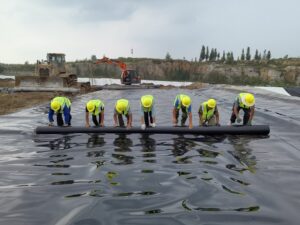What is the difference between geomembrane and concrete?
Geomembranes and concrete are two different materials used for different engineering applications. They have the following contrasting aspects:
Materials and properties:
Geomembrane: Geomembrane is usually made of plastic materials such as polyethylene (HDPE), polypropylene (PP), polyester (PET), etc. It has good impermeability and chemical stability. The geomembrane is soft, lightweight, has high tensile strength and tear resistance, and is suitable for engineering requirements such as seepage prevention and separation.
Concrete: Concrete is a hard material formed by pouring and curing a mixture of cement, aggregate, and mortar. Concrete has high compressive strength and hardness, suitable for load-bearing and structural engineering needs.

Use:
Geomembrane: Geomembrane is mainly used in engineering applications to prevent the penetration of soil and water, separate different materials, enhance soil stability, and protect the environment. Common applications include pools, reservoirs, embankments, seepage walls, landfills, and more.
Concrete: Concrete is widely used in construction and civil engineering to construct load-bearing structures such as houses, bridges, roads, and tunnels. Concrete has good compressive strength and durability, and is suitable for projects that need to bear loads and resist external forces.
Construction Difficulty:
Geomembrane: Compared with concrete, the construction of geomembrane is relatively simple. It is usually necessary to clean and level the surface, and then lay and fix the geomembrane. However, joint treatment and fixing of geomembrane requires professional skills and proper construction methods.
Concrete: The construction of concrete is relatively complicated, requiring a series of processes such as formwork construction, skeleton reinforcement layout, concrete pouring, and maintenance, requiring precise construction technology and professional equipment.

Cost:
Geomembrane: Compared with concrete, geomembrane is more economical in material cost. In addition, the construction of geomembrane is relatively simple and the construction period is short, which can reduce the cost of manpower and mechanical equipment.
Concrete: The cost of concrete mainly involves materials, labor, equipment, etc., which are relatively high. Concrete construction has a longer construction period and requires more labor and mechanical equipment costs.
It is necessary to choose whether to use geomembrane or concrete according to specific engineering needs and requirements.
In some cases, the two can also be used in combination to give full play to their respective advantages and meet specific engineering requirements.
Author

Founded in 2002, Tinhy's team focuses on the manufacturing, marketing, installation, application and research and development of geosynthetic materials.
View all posts





